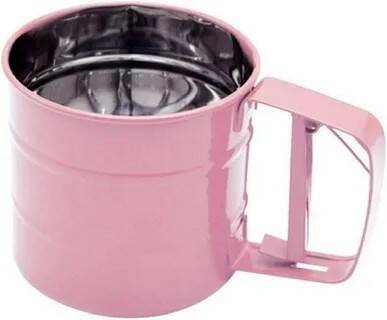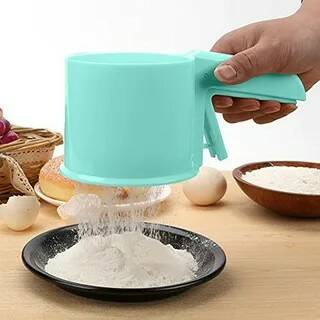
A mechanical flour sifter is a kitchen tool that is used to sift flour and other dry ingredients. It consists of a container with a mesh screen at the bottom and a crank handle on the side. When you turn the crank handle, the mesh screen rotates, causing the flour to pass through the screen and removing any lumps or impurities.
Here are some things you should know about mechanical flour sifters:
- Material: Mechanical flour sifters can be made of different materials, including plastic, stainless steel, and aluminum. Stainless steel is a popular choice because it is durable, easy to clean, and does not rust.
- Capacity: Mechanical flour sifters come in different sizes and capacities, ranging from small handheld sifters to larger countertop models. Choose a size that meets your needs and fits your kitchen space.
- Mesh size: The size of the mesh screen on the sifter can vary, with smaller mesh sizes producing finer flour and larger mesh sizes producing coarser flour. Choose a mesh size that is appropriate for the recipe you are making.
- Easy to use: Mechanical flour sifters are generally easy to use, with the crank handle making it easy to sift flour quickly and efficiently. They are especially useful for recipes that require a fine, light texture, such as cakes and pastries.
- Easy to clean: Most mechanical flour sifters are easy to clean, with the mesh screen and other parts easily removable for cleaning. Make sure to clean the sifter thoroughly after each use to prevent the buildup of flour and other ingredients.
By choosing a high-quality mechanical flour sifter that is appropriate for your needs, you can make baking and cooking easier and more enjoyable.
Material
Mechanical sieving devices for flour can be made of various materials, including plastic, stainless steel, aluminum, or a combination of these materials. The choice of material depends on the user’s preferences and the intended use of the sifter. Here are some things you should know about the different materials used in mechanical sieving devices:
- Plastic: Plastic sifters are lightweight and affordable, making them an attractive option for many home bakers. They are also easy to clean and maintain. However, plastic sifters may not be as durable as metal sifters, and they may not hold up well over time.
- Stainless steel: Stainless steel is a popular choice for mechanical sifters because it is durable, rust-resistant, and easy to clean. It is also a non-reactive material, which means it won’t interact with acidic ingredients or alter the taste of the flour. Stainless steel sifters may be more expensive than plastic sifters, but they are generally more durable and long-lasting.
- Aluminum: Aluminum sifters are lightweight and affordable, but they may not be as durable as stainless steel sifters. They are also prone to rusting, which can affect the quality of the flour. However, aluminum sifters are often a good choice for occasional use or for bakers on a budget.
- Combination materials: Some mechanical sifters are made of a combination of materials, such as plastic and stainless steel or aluminum and stainless steel. These sifters offer the benefits of both materials, such as the durability of stainless steel and the affordability of plastic or aluminum.
Overall, the material of the mechanical sieving device you choose depends on your preferences, budget, and how often you plan to use the sifter. A durable and easy-to-clean material like stainless steel may be worth the investment if you plan to use the sifter frequently or for commercial purposes, while a lightweight and affordable material like plastic or aluminum may be a better choice for occasional home use.
Capacity
Capacity is an important factor to consider when choosing a mechanical sieving device for flour. The capacity of the sifter will determine how much flour you can sift at once and how quickly you can sift it. Here are some things you should know about the capacity of mechanical sieving devices for flour:
- Small capacity: Small capacity sifters are typically designed for home use and can hold up to one or two cups of flour at a time. They are compact and easy to store, making them a good choice for home bakers who only need to sift small amounts of flour at a time.
- Medium capacity: Medium capacity sifters can hold up to four or five cups of flour at a time. They are a good choice for home bakers who need to sift larger amounts of flour for baking or cooking.
- Large capacity: Large capacity sifters are designed for commercial use and can hold up to ten or more cups of flour at a time. They are ideal for professional bakers or for home bakers who frequently bake in large quantities.
It’s important to choose a sifter with a capacity that matches your needs. If you only bake occasionally and don’t need to sift large amounts of flour at once, a small or medium capacity sifter may be sufficient. However, if you bake frequently or need to sift large amounts of flour at once, a large capacity sifter may be a better choice. Keep in mind that larger capacity sifters can be more expensive and may take up more space in your kitchen.
Mesh size
Mesh size is another important factor to consider when choosing a mechanical sieving device for flour. The mesh size of the sifter will determine the fineness of the flour that is sifted. Here are some things you should know about mesh size for mechanical sieving devices for flour:
- Fine mesh: A sifter with a fine mesh size will produce a very fine flour that is ideal for delicate baked goods like cakes and pastries. Fine mesh sifters are also good for removing any lumps or impurities from the flour.
- Coarse mesh: A sifter with a coarse mesh size will produce a coarser flour that is ideal for hearty baked goods like bread and pizza dough. Coarse mesh sifters are also good for sifting out larger pieces of bran or other coarse particles from the flour.
- Adjustable mesh: Some mechanical sieving devices for flour come with an adjustable mesh size, allowing you to customize the fineness of the flour based on your needs. This can be a great option if you plan to use your sifter for a variety of baked goods.
It’s important to choose a sifter with a mesh size that matches your baking needs. If you bake a lot of delicate baked goods like cakes and pastries, a sifter with a fine mesh size may be ideal. If you bake a lot of bread and other hearty baked goods, a sifter with a coarse mesh size may be more suitable. An adjustable mesh size sifter can be a great option if you plan to use your sifter for a variety of baked goods.

Easy to use
Ease of use is an important consideration when choosing a mechanical sieving device for flour. Here are some things you should know about ease of use for mechanical sieving devices for flour:
- Crank handle: Many mechanical sifters come with a crank handle that you turn to sift the flour. This https://www.buydo.eu can be a very easy and efficient way to sift flour, as long as the handle is easy to turn and the sifter is well-balanced.
- Trigger mechanism: Some sifters have a trigger mechanism that you squeeze to sift the flour. This can be a good option if you have limited hand strength or mobility, but it can be more difficult to control the flow of flour.
- Capacity: The capacity of the sifter is also an important consideration for ease of use. A larger sifter may be more efficient for sifting large quantities of flour, but it can be more difficult to hold and control. A smaller sifter may be easier to handle, but it may take longer to sift the flour.
- Cleaning: The ease of cleaning the sifter is also an important consideration for ease of use. Look for a sifter that is easy to disassemble and clean, with no small crevices or hard-to-reach areas.
When choosing a mechanical sifter, look for one that is easy to use and maintain. A crank handle can be a very efficient way to sift flour, as long as it’s easy to turn. A trigger mechanism can be a good option if you have limited hand strength or mobility. Choose a sifter with a capacity that matches your needs and is easy to handle. Finally, look for a sifter that is easy to clean and maintain.
Easy to clean
Easy cleaning is an important aspect to consider when choosing a mechanical flour sifter. Here are some things to keep in mind:
- Design: Look for a sifter with a simple and straightforward design that is easy to disassemble and clean. A sifter with fewer parts and no hard-to-reach areas is easier to clean.
- Materials: Choose a sifter made from materials that are easy to clean and resistant to rust and corrosion. Stainless steel is a good option as it is durable and easy to clean.
- Dishwasher safe: Check to see if the sifter is dishwasher safe. If it is, it will be much easier to clean as you can simply place it in the dishwasher.
- Cleaning tools: Some sifters come with specialized cleaning tools that make it easier to clean hard-to-reach areas. Look for sifters that include these tools or have easily accessible areas that can be cleaned with a regular brush or sponge.
- Avoid wood: Avoid sifters with wooden parts as they can absorb moisture and develop mold or bacteria, which can be difficult to clean.
Remember to clean your sifter after each use to prevent flour buildup and contamination. With a well-designed sifter and proper cleaning techniques, you can easily maintain a clean and hygienic sifter for your flour.

0 Comments for “Sifter Kitchen Baking Tool”